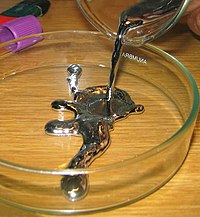
Photo from wikipedia
Abstract Thermodynamic equilibrium calculations were performed to reveal effects of interactions among Cl, S, P and other minerals on Cu migration. Our results showed that HCl(g), SO2(g) and (P2O5)2(g) were… Click to show full abstract
Abstract Thermodynamic equilibrium calculations were performed to reveal effects of interactions among Cl, S, P and other minerals on Cu migration. Our results showed that HCl(g), SO2(g) and (P2O5)2(g) were released from the sewage sludge co-incineration. Cl was found to weaken adsorption of Cu by Al2O3, CaO and Fe2O3, while S delayed reactions of Fe2O3 and Al2O3 with Cu, with P having no effect on reactions between the minerals and Cu. Among the coupled systems of Cl, S and P, the co-existences of Cl and S, and Cl, S and P were determined to inhibit Cu volatilization, and the co-existence of Cl and P had an enhancing effect. Cu migration was affected only by S in the S and P system. With the SiO2, CaO and Al2O3 system, both Cl alone and Cl and P led to failed reactions between the minerals and Cu. In the systems of S, S and Cl, S and P, and S, Cl and P, the migration behavior of Cu was mainly affected by S at low temperatures and by Cl at high temperatures, whereas P had no effect on Cu migration during the entire process.
Journal Title: Chinese Journal of Chemical Engineering
Year Published: 2017
Link to full text (if available)
Share on Social Media: Sign Up to like & get
recommendations!